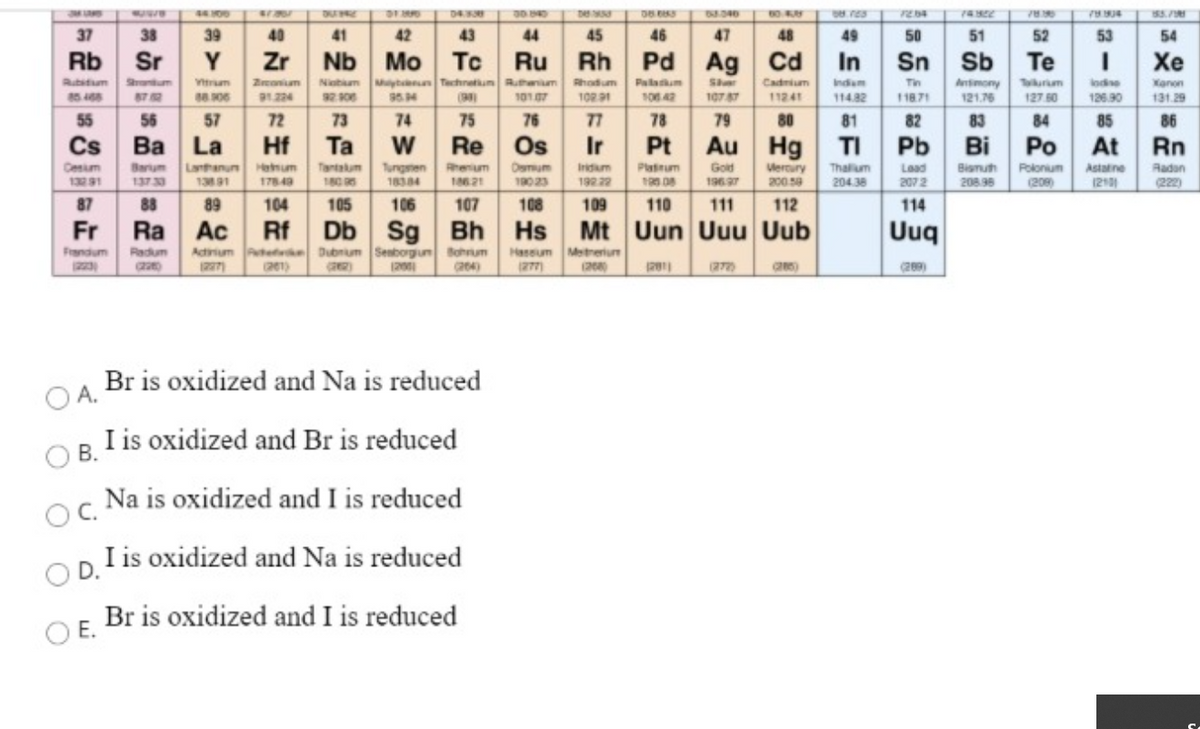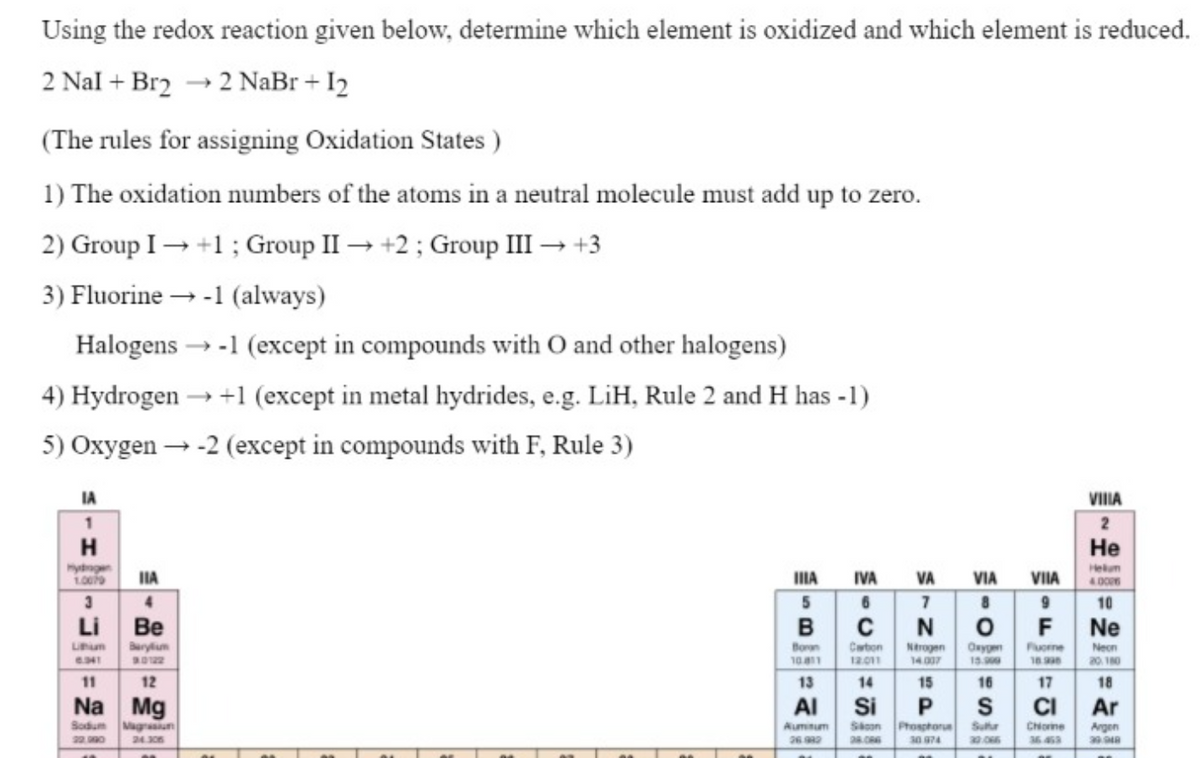Chemistry: The Molecular Science
5th Edition
ISBN:9781285199047
Author:John W. Moore, Conrad L. Stanitski
Publisher:John W. Moore, Conrad L. Stanitski
Chapter3: Chemical Reactions
Section: Chapter Questions
Problem 113QRT
Related questions
Question

Transcribed Image Text:DE
eres
155./
37
38
39
40
41
42
43
44
45
46
47
48
49
50
51
52
53
54
Rb SrY Zr Nb Mo Tc
Ru Rh Pd Ag Cd
In
Sn
Sb Te
I Xe
Mytnn Technetium Ruthenium
10107
Palaum
Sar
Atimony
121.76
Strum
Vtrm
Xonon
131.29
Rubstum
Zeanum
Nobm
Rhodum
Cadmium
Indiam
Tin
urm
lodse
87 2
91.224
10291
10 42
1077
11241
11482
11871
127 50
12630
55
56
57
72
73
74
75
76
77
78
79
80
81
82
83
84
85
86
Cs Ba La
Та
Re
Os
Au Hg TI Pb
Bi Po
Hf
Barum Lanthanun Hanum
17849
W
Pt
At Rn
Cesim
13291
Tantalum
180
Tungnen
18384
Osmum
19023
Gold
19697
Bisnuh
208.98
Rhenum
Inidum
Platirum
Vercury
200 5e
Thalum
20438
Laad
Polonum
Astatine
Radan
137 33
1391
18621
192 22
2072
(20
1210
(222)
87
88
89
104
105
106
107
108
109
110
111
112
114
Fr Ra Ac
Rf Db
Actinium tee Dubnium Senborgiun Bohnum
Sg Bh
Hs Mt Uun Uuu Uub
Hassum Metnerium
Uuq
Frandum
Radum
1287)
201)
120
(2
(27
29)
Br is oxidized and Na is reduced
O A.
I is oxidized and Br is reduced
В.
OC.
Na is oxidized and I is reduced
I is oxidized and Na is reduced
Br is oxidized and I is reduced

Transcribed Image Text:Using the redox reaction given below, determine which element is oxidized and which element is reduced.
2 Nal + Br2 → 2 NaBr + 12
(The rules for assigning Oxidation States )
1) The oxidation numbers of the atoms in a neutral molecule must add up to zero.
2) Group I → +1 ; Group II → +2 ; Group III → +3
3) Fluorine → -1 (always)
Halogens → -1 (except in compounds with O and other halogens)
4) Hydrogen
+1 (except in metal hydrides, e.g. LiH, Rule 2 and H has -1)
5) Oxygen
-2 (except in compounds with F, Rule 3)
IA
VIIIA
H
Не
yngen
1.00
Helum
IIA
IIIA
IVA
VA
VIA
VIIA
4.0006
3
10
Li
Ве
B CNo
F Ne
Burylum
Born
10 11
Caton
12.011
Onygen
13
Fuorne
18
Lum
Ntrogen
14.007
Neon
20 I0
11
12
13
14
15
16
17
18
Mg
Magnasiun
Si
CI
Na
AI
S
Ar
Phosptorue
30 974
Sodum
Skoon
Sutr
Chorine
36.453
Auminum
Argen
220
Expert Solution
This question has been solved!
Explore an expertly crafted, step-by-step solution for a thorough understanding of key concepts.
Step by step
Solved in 2 steps

Knowledge Booster
Learn more about
Need a deep-dive on the concept behind this application? Look no further. Learn more about this topic, chemistry and related others by exploring similar questions and additional content below.Recommended textbooks for you

Chemistry: The Molecular Science
Chemistry
ISBN:
9781285199047
Author:
John W. Moore, Conrad L. Stanitski
Publisher:
Cengage Learning

Chemistry & Chemical Reactivity
Chemistry
ISBN:
9781337399074
Author:
John C. Kotz, Paul M. Treichel, John Townsend, David Treichel
Publisher:
Cengage Learning

Chemistry & Chemical Reactivity
Chemistry
ISBN:
9781133949640
Author:
John C. Kotz, Paul M. Treichel, John Townsend, David Treichel
Publisher:
Cengage Learning

Chemistry: The Molecular Science
Chemistry
ISBN:
9781285199047
Author:
John W. Moore, Conrad L. Stanitski
Publisher:
Cengage Learning

Chemistry & Chemical Reactivity
Chemistry
ISBN:
9781337399074
Author:
John C. Kotz, Paul M. Treichel, John Townsend, David Treichel
Publisher:
Cengage Learning

Chemistry & Chemical Reactivity
Chemistry
ISBN:
9781133949640
Author:
John C. Kotz, Paul M. Treichel, John Townsend, David Treichel
Publisher:
Cengage Learning

Chemistry: Principles and Reactions
Chemistry
ISBN:
9781305079373
Author:
William L. Masterton, Cecile N. Hurley
Publisher:
Cengage Learning

World of Chemistry, 3rd edition
Chemistry
ISBN:
9781133109655
Author:
Steven S. Zumdahl, Susan L. Zumdahl, Donald J. DeCoste
Publisher:
Brooks / Cole / Cengage Learning

Chemistry: Matter and Change
Chemistry
ISBN:
9780078746376
Author:
Dinah Zike, Laurel Dingrando, Nicholas Hainen, Cheryl Wistrom
Publisher:
Glencoe/McGraw-Hill School Pub Co